Weighing in: Craft CMS vs WordPress
From the Journal – Posted 13.05.2025

Every web designer or developer worth their salt will have an opinion on this: Craft CMS or WordPress?
These two contenders of the CMS world may appear to be ill-matched, given the heavyweight reputation of WordPress, but as the demands of digital marketing evolve, which one would come out on top in 2025?
We thought it was about time we weighed in on this match of the ages. And as we’re a certified Craft CMS partner, it should also be no surprise whose corner we’re in…
…but in the interest of fair competition, let’s take a good look at what makes these two worthy competitors. That way, we can evaluate just how their strengths stack up in the context of the digital requirements businesses have in 2025.
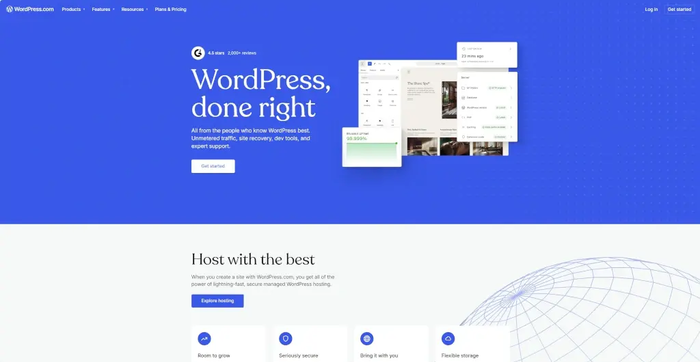
What is WordPress?
WordPress was launched back in 2003 as an open-source blogging platform. And while it became popular almost overnight, it was the release of WordPress 3.0 in 2010, which introduced custom post types, and taxonomies, that established it as a feature-rich and powerful content management system (CMS)
Today, nearly 564 million websites are built using WordPress. It is the most widely used CMS, accounting for 43.5% of all websites, and is still often the first choice for anyone who needs a CMS.
The fact is that WordPress has everything you need to build a high-quality website; there are tens of thousands of themes to choose from, an unrivalled plug-in ecosystem, and a vast support community.
If you need any more proof of its sheer dominance, just look at the brand names that put their trust in it: Samsung, Microsoft, The New York Times, Al Jazeera, Spotify, and even NASA all use WordPress for their websites.
So, obviously, when it comes to reputation, WordPress is the reigning champion of the CMS. So why would we put it in the proverbial ring with its much less widely known opponent, Craft CMS?
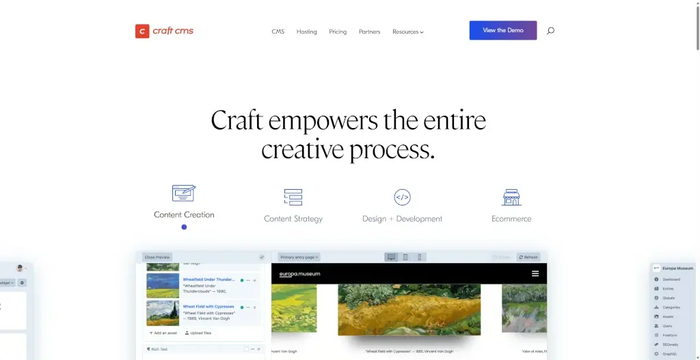
What is Craft CMS?
Founded in 2013 by software company Pixel & Tonic, Craft CMS is a modern CMS platform that offers brands unrivalled customisation. While it may be 10 years younger and be no match for the popularity of its rival, accounting for a mere 43,000 websites, you’d be wrong to disregard Craft CMS as an unworthy competitor.
Craft was designed to be - and still is - a flexible, developer-first CMS that prioritises clean code, structured content, and optimised performance.
💡Further reading: 5 Reasons to Choose Craft CMS for Your Website
It is these flexibility, security, and performance credentials that are tempting more and more businesses that want scalable, long-term solutions that prioritise user-friendly management. Craft CMS’s reputation may appear paltry in comparison, but it's the CMS of choice for some of the world's largest and most recognisable brands, including:
- IKEA
- Volkswagen
- Adidas
- Netflix
- Hootsuite
Want to know more about why developers are choosing this supposed underdog? Let’s take a closer look.
Craft CMS vs. WordPress: pros and cons
Design and development
While on paper it may seem sensible to compare CMS capabilities first, to understand why we’re putting Craft CMS in the ring with WordPress, you need to know a little more about their origin stories.
WordPress was built for all the DIY-ers out there. Its goal was to enable anyone to create a blog, or website, and start publishing their content online without relying on the cost and technical experience of a developer.
As such, to meet the demands of digital ambitions, WordPress evolved to offer an unrivalled selection of pre-built themes, that determine the look, feel, and functionality of sites in one easy-to-install package. These themes are ideal for those who need a quick start and are happy to work within the limitations of the template.
But, as businesses grow and mature, these templates can start to feel rigid, and restrict any kind of additional customisation to those with technical coding expertise. It’s common for businesses to end up with a hodge-podge of plug-ins to achieve their goals, which, while on one hand can be cheap and fast to deliver, on the other, this approach can lead to security and maintenance issues over time, which we’ll get into a bit further down.
Matt Powell | Creative Director, MUDWordPress gives you endless pre-built themes that are perfect for small businesses on a budget. But if you want a site that grows with you and adapts to your unique needs, Craft CMS is built for that.
Craft CMS is a developer-oriented platform, built for a business audience who need a high-performance, professional site as a minimum, which explains why it’s increasingly the go-to choice for leading web design agencies!
As such, there are no pre-built themes, and brands work with their chosen web designers and developers to create a fully-custom site designed specifically around their needs. What’s more, not only does it offer web development professionals the flexibility to produce stand-out websites for their clients, but Craft CMS’s user-friendly interface makes it easy for those clients, moving forward, to manage their website content independently with ease.
If you’re a small business with a limited budget, WordPress wins every day of the week. If you’ve got bigger ambitions and need every touchpoint to support your brand optics from day one, while being scalable as you grow, it’s Craft CMS that scores the points in this first round.
Content management
The purpose of a CMS is straightforward; it supports content creation and evolution. But there’s evidence to suggest that even this basic requirement isn’t being fulfilled — an eye-popping 93% of brands surveyed say their CMS is limiting their capabilities. Today, dynamic businesses that are continuously evolving their digital presence need a CMS with the same dynamic capabilities, to serve their content-led approach to marketing online.
Craft CMS’s underlying power is simple; each site is custom by default. It gives brands more control, plus, a more customised, structured approach to content. This provides users more flexibility when it comes to creating; matrix fields allow complex media-rich pages to be built by internal website managers with no need for multiple plug-ins or external developer support. It’s a game-changer for those brands that prioritise the experiential value of their digital platform as part of their customer experience.
WordPress, on the other hand, its default isn’t a blank canvas. Originally developed to allow anyone to build themselves a blog to write and publish articles, regardless of technical experience, it has retained this baseline framework, which can then be augmented and developed to meet custom preferences.
So, to get the kind of content-led flexibility brands now come to expect, you’ll need a lot of plug-ins and add-ons to make your WordPress website win this round. Manageable, but messier…
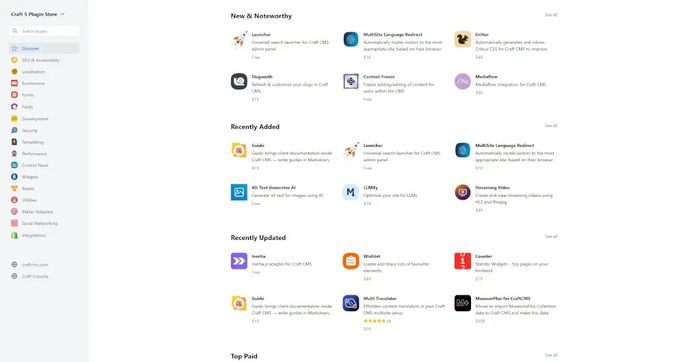
Plug-ins
…which leads us nicely into the subject of plug-ins.
If we’re looking at the numbers, again, the quantity available through WordPress dominates; there are some 60,000 to Craft’s 500.
No brainer? Not exactly...
The reality means the sheer quantity of plug-ins means the quality of WordPress’ third-party site extensions is far from guaranteed, and can prove to be the Achilles heel of your site. Simply put, the more plug-ins you have, the greater the risk of security and performance issues. Each plug-in weighs down your website a little more; plug-ins don't always play nicely together, and updates can create vulnerable spots for hackers to gain access.
With so many options and a greater reliance on plug-ins for functionality, you end up with a more complex amalgamation of CMS admin screens, and a headache when it comes to keeping things up-to-date, secure, and properly licensed.
Craft CMS, on the other hand, doesn't rely so heavily on plug-ins for its functionality. It’s capable of offering many of the features you require for your CMS as a core part of the platform. If you do need a plug-in to extend the functionality of your site - and we use several specialist plugins on all of our sites - the quality of the plug-ins available through the official store is much more rigorously scrutinised by the community of Craft CMS-committed developers who use them.
Some of our favourite Craft CMS plug-ins are:
- Navigation - provides a fully-editable mega-menu structure
- SEOmatic - provides structured and easily manageable SEO data
- Imager X - create optimised, responsive imagery
- Formie - create fully customisable forms
- Blitz - effective caching for performance optimisation
- FeedMe - manage scheduled importing of content
- Sprig - create reactive, dynamic components
💡Further reading: The 10 Best Craft CMS Plugins in 2025
When it comes to quality versus quantity, it’s Craft CMS that wins this round.
SEO
Driving traffic to your brand and business is one of your website’s primary functions, which is why one of the first plug-ins you’ll install both for Craft CMS and WordPress will be an SEO plug-in.
Considering both use a plug-in to support effective search engine optimisation, is there much in it?
Yoast SEO is the SEO plug-in of choice for WordPress users. It analyses pages, scores the content and meta data with a simple traffic light system, and provides recommendations for authors to optimise their content.
SEOmatic is the top choice for Craft CMS developers with good reason; it makes modern SEO practices turnkey for every kind of business. Powerful and easy-to-use, it’s part of our default setup for clients to prioritise optimisation from the very beginning of each project.
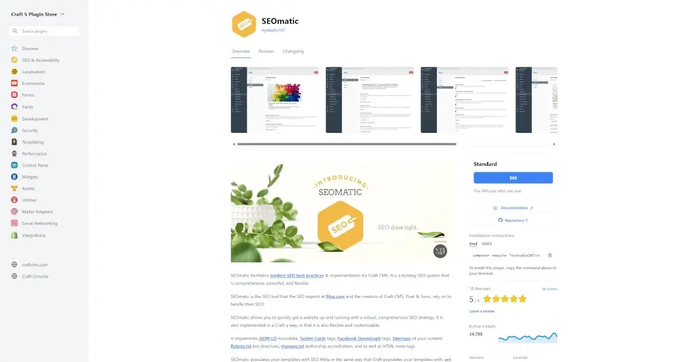
But organic performance is about more than plugins like Yoast SEO and SEOmatic. Search engine algorithms prioritise websites that deliver frictionless journeys for users - factors like site speed and clean code are hugely important.
Both systems can deliver well-built websites set up to perform organically, but there are differences. Generally speaking, WordPress sites can be hampered by unoptimised hosting and excessive plug-in usage, all of which affect overall search rankings.
These problems can affect Craft CMS sites too, but as the platform offers greater control over the infrastructure, architecture, and metadata from the start, with less external plug-in interference, it better supports the development of well-optimised sites for search engines.
Is there enough in the SEO standoff for there to be a clear winner? Let’s call this one a draw.
Security
When it comes to security, WordPress’s size is no longer something to celebrate. The sheer number of installs means WordPress sites are prime targets for hackers — according to estimations, 1 in 25 of WordPress sites are hacked. And remember what we were saying about plug-ins being the Achilles heel of your site? We weren’t being dramatic; some 94% of these vulnerabilities are plug-in related.
But the positive news for WordPress users is that with rigorous maintenance and frequent updates of core software, plug-ins, and themes, you can protect your website from the majority of malicious actors.
How does Craft CMS compare? The simple fact is as a modern development platform, it’s secure by design, and relies so much less on plug-ins that the vulnerabilities are minimal in comparison.
Craft CMS has a number of built-in security measures that mean it's secure at a core level. Craft CMS uses PDO for all database queries to help prevent SQL injection attacks. It validates sensitive cookie data using a private key. This ensures that no request cookies have been tampered with. And it uses CSRF token validation to guard against CSRF attacks.
If we were to trust one with our client’s businesses? You’ve guessed it, it would be Craft CMS.
Performance
We know that page speed is a factor in Google’s ranking algorithm, and we know from survey results that the average load speed for a top Google search result is 1.65 seconds. So, although there are many variables that impact loading time, when it comes to selecting your CMS, speed and agility matter.
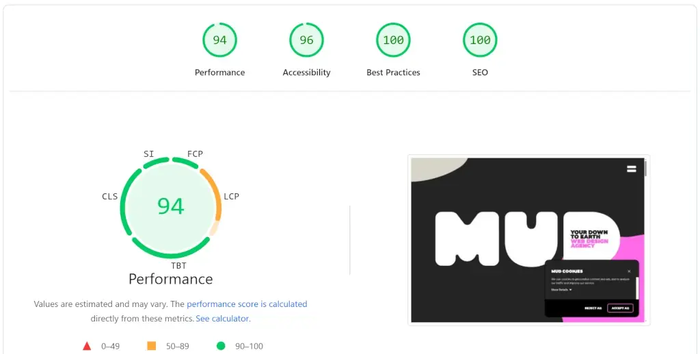
Craft CMS’s lean core and architecture, with much of the functionality is already ‘baked in’, means it can operate more efficiently. A cleaner, lighter code base results in a website less weighed down by the added complexity of plug-ins.
In comparison, WordPress is the heavyweight in this context; its monolithic architecture and reliance on plug-ins mean that historically, it doesn’t scale for performance efficiently. Recommendations for scaling and optimising WordPress sites often involve installing more plug-ins, which in turn leads to cumbersome code and a bloated site, or situations where developers are trying to overcome issues introduced by them. All of which equals a slower, less effective site.
For large organisations, their WordPress VIP platforms address these long-standing pain points. Built specifically for ‘enterprise-grade’ organisations that need powerful performance, the infrastructure and architecture of WordPress VIP have been designed to support high traffic volumes and fast load times. The only not-so-small consideration is the cost, which starts from around $25,000 per annum.
Which cues us up nicely for the next round…
Cost
But how do the costs measure up when you’re not a behemoth of the internet?
There’s no escaping the fact that WordPress, as an entry-level CMS for beginners, is free to use at first glance. But again, to risk sounding like a broken record over here, start to scale your WordPress site, and that’s when the costs go up.
From external hosting to premium themes and integrations, customising your WordPress site beyond basic templates adds up, fast. What’s more, as we’ve addressed, the security, support, and performance improvements often required with WordPress sites can lead to increased maintenance fees over the long term.
Craft CMS licence fee costs start at $399 upfront for businesses, plus the ongoing update fees as indicated on their website. Here at Mud, we typically spend another few hundred dollars on the essential plug-in licences to provide our clients with high-performing websites that they can manage efficiently moving forward. From our experience, once you set up, Craft CMS, then accrues little in the way of extra costs in the long-term because of its secure and scalable nature.
So, when it comes to factoring in your budget, Craft CMS wins for clear, upfront cost effectiveness.
Accessibility
In recent years, website accessibility has come into sharp focus. And it's easy to see why; in the UK, 1 in 5 people have a long-term illness, impairment, or disability.
That means that when it comes to making the web more accessible, both WordPress and Craft CMS put all of their cards on the table, aiming to meet the current Web Content Accessibility Guidelines (WCAG) and Authoring Tool Accessibility Guidelines (ATAG).
In terms of inclusivity, it comes down to how each CMS platform operates. To make your WordPress site accessible to those users with disabilities, you need to choose an accessible theme for starters, and, you guessed it, install the right plug-ins.
Accessibility isn't an add-on at Craft CMS; developers can build sites to current standards without any limitations, to serve the additional needs of both internal (the content editors or authors) and external (website users) audiences.
If you need some more validation, look no further than the endorsement from Simon Jones at Studio 24 on Craft CMS’s Accessibility page. Tasked with delivering a new site for the World Wide Web Consortium, the standard bearer for web accessibility, Studio 24 worked with W3C to test out a selection of three CMS platforms, including WordPress. The CMS they chose? It was Craft CMS!
And they’ve been making leaps and bounds in improvements since then, demonstrating their commitment to providing a market-leading, accessible platform from both an experience and authoring perspective.
Craft CMS or WordPress: which should you choose?
Who comes out on top?
As far as we’re concerned, as a modern development platform that pays close attention to what matters to the professional digital requirements of brands today, Craft CMS is our clear winner.
Craft CMS gives us everything we need to develop beautiful, custom sites for our clients, and we know that we can ensure that each site performs well now and in the future as needs change and grow. We’re part of the growing community of developers trusting in and championing the flexibility of this powerful CMS.
Each site is technically optimised for SEO, and with SEOMatic, optimising on-page SEO is as simple as possible for editors. And we trust in the CMS as being the most user-friendly we can offer our clients, so they have the freedom and independence to maintain, update, and adapt their own content, rather than relying on our time to support their marketing and operations.
Plus, by developing sites using our baseline of essential plug-ins, we can be transparent and upfront with Craft CMS costs and integrations, negating the risk of unforeseen costs that come with the potential additions needed to maintain the performance of a legacy platform.
If you can see the benefits of choosing Craft CMS to evolve your brand’s digital presence, talk to the Mud team today. We’re a verified Craft CMS partner, and experts in designing and developing websites that maximise the performance potential of this CMS platform to provide future-proof digital spaces for brands to grow.